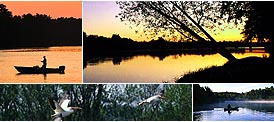


Wildlife Information
Alligators
Black Bear
Whooping Crane
Bald Eagle
Manatee
Florida Panther
Brown Pelican
Florida Wildlife - Bald Eagle
The bald eagle is truly an all-American bird -- it is the only eagle unique to North America. It ranges over most of the continent, from the northern reaches of Alaska and Canada down to northern Mexico.
While our national symbol was in danger of extinction throughout most of its range 25 years ago, the bald eagle has made a tremendous comeback, its populations greatly improving in numbers, productivity, and security in recent years. Male bald eagles generally measure 3 feet from head to tail, weigh 7 to 10 pounds, and have a wingspan of about 6 1/2 feet. Females are larger, some reaching 14 pounds and having a wingspan of up to 8 feet. This striking raptor has large, pale eyes; a powerful yellow beak; and great, black talons. The distinctive white head and tail feathers appear only after the bird is 4 to 5 years old. Bald eagles are believed to live 30 years or longer in the wild, and even longer in captivity. They mate for life and build huge nests in the tops of large trees near rivers, lakes, marshes, or other wetland areas. Nests are often re-used year after year. With additions to the nests made annually, some may reach 10 feet across and weigh as much as 2,000 pounds. Although bald eagles may range over great distances, they usually return to nest within 100 miles of where they were raised. Bald eagles normally lay two to three eggs once a year and the eggs hatch after about 35 days. The young eagles are flying within 3 months and are on their own about a month later. However, disease, lack of food, bad weather, or human interference can kill many eaglets; sometimes only about half will survive their first year. The staple of most bald eagle diets is fish, but they will feed on almost anything they can catch, including ducks, rodents, snakes, and carrion. In winter, northern birds migrate south and gather in large numbers near open water areas where fish or other prey are plentiful. Wildlife experts believe there may have been 25,000 to as many as 75,000 nesting bald eagles in the lower 48 states when the bird was adopted as our national symbol in 1782. Since that time, the bald eagle has suffered from habitat destruction and degradation, illegal shooting, and contamination of its food source, most notably due to the pesticide DDT. By the early 1960s there were fewer than 450 bald eagle nesting pairs in the lower 48 states. Bald eagles have few natural enemies. But in general they need an environment of quiet isolation; tall, mature trees; and clean waters. Those conditions have changed over much of the bald eagle's former habitat. Meanwhile, these birds of prey became prey themselves. Although primarily fish and carrion eaters, bald eagles and other raptors were seen as marauders that killed chickens, lambs, and other domestic livestock. As a consequence, large numbers were shot by farmers, ranchers, and others. In 1940, noting that the national bird was "threatened with extinction," Congress passed the Bald Eagle Protection Act which made it illegal to kill, harass, possess (without a permit), or sell bald eagles. In 1967, bald eagles were officially declared an endangered species (under a law that preceded the Endangered Species Act of 1973) in all areas of the United States south of the 40th parallel. Federal and state government agencies, along with private organizations, successfully sought to alert the public about the bald eagle's plight and to protect its habitat from further destruction. The greatest threat to the bald eagle's existence arose from the widespread use of DDT and other pesticides after World War II. DDT was sprayed on croplands throughout the country and its residues washed into lakes and streams. There, they were absorbed by aquatic plants and small animals that were eaten by fish. The contaminated fish, in turn, were consumed by bald eagles. The chemical interfered with the bald eagle's ability to develop strong shells for its eggs. As a result, bald eagles and many other bird species began laying eggs with shells so thin they often broke during incubation or otherwise failed to hatch. Their reproduction disrupted, bald eagle populations plummeted. As the dangers of DDT became known, in large part due to Rachel Carson's famous book Silent Spring, this chemical was banned for most uses in the U.S. in 1972. In addition to the adverse effects of DDT, bald eagles also died from lead poisoning as a result of feeding on hunter-killed or crippled waterfowl containing lead shot and from lead shot that was inadvertently ingested by the waterfowl. (In 1991, a 5- year program to phase out the use of lead shot for waterfowl hunting was completed by the U.S. Fish and Wildlife Service.) Gradually, the Fish and Wildlife Service assembled the largest colony of breeding bald eagles in captivity at its Patuxent Wildlife Research Center near Laurel, Maryland, in a major effort to return healthy eagles to the wild (the center is now run by the National Biological Service). Patuxent's scientists enhanced the species' breeding potential by removing the bald eagle's first clutch of eggs and incubating them artificially. The bald eagles would usually then lay a second clutch, which the birds were allowed to incubate themselves. In all, 124 bald eagles were hatched at Patuxent. These captive-hatched bald eagles were an important source for restocking wild populations in certain areas of the country and helped to reestablish a broader distribution. Patuxent's program came to an end in 1988, as bald eagles began to reproduce more successfully in the wild, and the center turned its efforts toward other more critically endangered species. Some states continue reintroduction efforts, and two methods are generally used. Eaglets used for reintroduction may be captive-hatched or, since usually only two young per nest survive, they may be transferred from a bald eagle nest with a clutch of more than two. These "extra" eaglets are placed in the nest of an adult pair whose own eggs are infertile or fail to hatch. The "foster parents" readily adopt the chicks and raise them as their own. Another method, called hacking, is a procedure adapted from the sport of falconry. At 8 weeks of age, nestling eaglets are placed on manmade towers located in remote areas where bald eagle populations are low or non-existent. The eaglets are kept in an enclosure and fed by humans who stay out of sight. When the birds are capable of flight, at about 12 weeks old, the enclosure around the artificial nest is opened and the birds are free to leave. Food is still provided at the release site until the birds learn to fend for themselves in the wild. With these and other recovery methods, as well as habitat improvement and the banning of DDT, bald eagle populations have steadily increased. From fewer than 450 nesting pairs in the early 1960s, there are now nearly 4,500 adult bald eagle nesting pairs and an unknown number of young and subadults in the conterminous U.S. In the last few years, several states have had breeding bald eagles for the first time in years. Until recently, the bald eagle was listed as endangered under the Endangered Species Act in 43 of the lower 48 states and listed as threatened in Michigan, Minnesota, Oregon, Washington, and Wisconsin. (There are about 40,000 bald eagles in Alaska and none in Hawaii.) "Endangered" means a species is considered in danger of extinction throughout all or a significant portion of its range, while "threatened" is a less dire category, meaning a species is considered likely to become endangered but not in danger of extinction. Then, in July 1995, the Fish and Wildlife Service announced that bald eagles in the lower 48 states have recovered to the point that those populations that were previously considered endangered are now considered threatened. Subsequently, the Service formally upgraded those populations under the Endangered Species Act to mark this progress -- another endangered species success story. While habitat loss still remains a threat to the bald eagle's full recovery, most experts agree that its recovery to date is encouraging. Soon our national symbol soaring the skies may become a common sight for Americans to once again behold.
Information provided by:
Fish and Wildlife Service
















